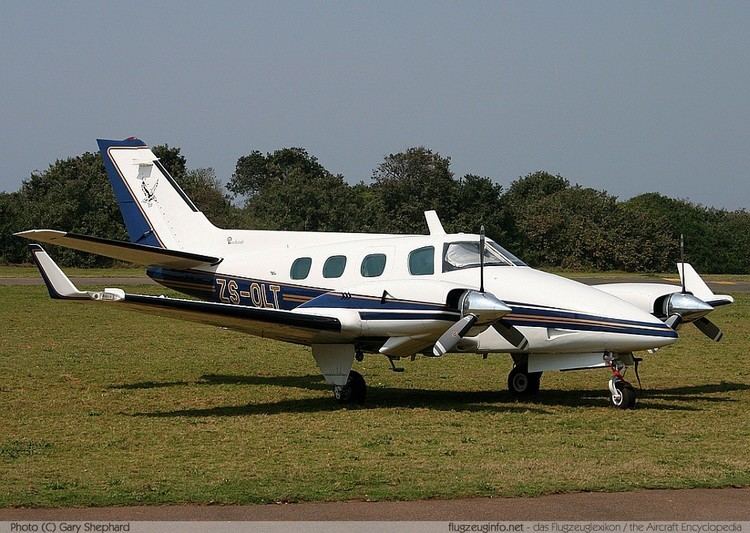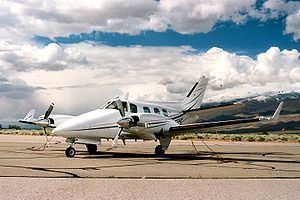Top speed 459 km/h Length 10 m | Wingspan 12 m | |
 | ||
Beechcraft duke flight ksjc ksjc
The Beechcraft 60 Duke is an American-built twin-engine fixed-wing aircraft created by Beechcraft. The aircraft has retractable tricycle landing gear and a pressurized cabin. The two piston engines are turbocharged and the turbochargers also pressurize the cabin with bleed air.
Contents
- Beechcraft duke flight ksjc ksjc
- 1977 beechcraft duke b60 for sale
- Design
- Modifications
- Operation
- Specifications B60
- Military operators
- References

1977 beechcraft duke b60 for sale
Design
The development of the Beechcraft 60 began in early 1965 and it was designed to fill the gap between the Beechcraft Baron and the Beechcraft Queen Air. On 29 December 1966 the prototype made its first flight. On 1 February 1968 the FAA issued the type certificate. Distribution to customers began in July 1968. The passenger cabin is fitted with club seating and entry is by means of a port-side airstair entry door in the rear fuselage.
The Beechcraft A60, which came onto the market in 1970, represented an advancement over the Baron, with an improved pressurized cabin utilizing advanced bonded honeycomb construction, lighter and more efficient turbochargers, and improved elevators. The last variant, the B60, was introduced in 1974. The interior arrangement was renewed and the engine efficiency again increased by improved turbochargers. The Beechcraft 60 was, despite its very good performance, only a moderate seller, principally because the complicated technology demanded a high expenditure on maintenance. Production was stopped in 1983.
Most of the Duke B-60s still flying have retained their original equipment. Electro-mechanical systems, which were highly advanced when the aircraft was introduced, were superseded in other aircraft with simpler I/C controlled mechanical parts. The aircraft design uses turbocharged Lycoming TIO541-B4 engines that develop 380 hp each. Other systems, parts, and FAA certified technicians are increasingly difficult to locate. Normally, pilots figure 45 gallons per hour, plus another 40 gallons for each takeoff and climb as typical fuel consumption for cross country planning. Owners compare the Beechcraft B60 to classic sports cars—noting that they do not fly Dukes to economize. One area of particular maintenance concern involves the original construction of the tail section from a magnesium alloy, making that section of the airframe a common and expensive target of corrosion if not detected and treated quickly.
Modifications
Some Dukes have been modified by Rocket Engineering of Spokane, Washington, replacing the Lycoming reciprocating engines with Pratt & Whitney Canada PT6A-21 or -35 turbine engines. Called the Royal Turbine Duke conversion, the modification increases fuel capacity by 28 gallons and the maximum useful load by 400 pounds. The take-off length required is shortened by over 1,500 feet to only 1,000 feet and the landing distance is reduced by over 2,000 feet to only 900. The maximum rate of climb is increased from 1,600 feet per minute to 4,000 feet per minute, reducing the time to climb to 25,000 feet from 25 minutes to 9 minutes. The cruise speed is increased to 290 knots at 29,000 feet. The modification does have some disadvantages as it increases fuel burn from 56 gallons per hour to 66 and lowers the certified ceiling from 30,000 feet to 28,000.
The supplemental type certificate was issued on May 12, 2006.
Operation
The Duke was purchased by corporate and private pilot owners. Most were registered in the United States but examples were exported to many countries including Argentina, Australia, Brazil, Canada, Croatia, Finland, France, Germany, Honduras, Iceland, Serbia, Slovenia, Sweden, Switzerland, South Africa and the United Kingdom. One Duke was flown by the Jamaica Defense Force. Many remain in service in the early twenty-first century.
In reviewing the aircraft in 2008, Rick Durden of AVweb stated, "Built to the quality standards of a King Air, the six-place Duke sported 380-hp, Lycoming TIO-541 engines -- rare beasts, those -- which means when both come due for overhaul, the choice is the overhaul or buying a small house in the Midwest. The assertive lines of the airframe made for a startlingly attractive airplane, but lead to high costs of manufacture and, surprising to the casual onlooker, horrendous drag. There are those who claim that the Duke was purposefully designed to be about 30 knots slower than it could easily have been on the available power simply because otherwise it would have been faster than the flagship of the Beech line, the King Air. The roughly 230-knot max. cruise speed is only marginally less than that of a King Air 90 and about the same as a Cessna 421, which carries more on slightly less horsepower. While the Duke shares the delightful handling of the Beech line, should pilots have the joy of single-engine operation, they will be up against the highest rudder-force of any piston twin -- 150 pounds at Vmc -- which happens to be the maximum the FAA allows. Owners report buying a Duke partially because of its looks, but selling it because of the cost of keeping it running. They describe King Air maintenance costs in a piston-twin airframe and recognize that the value of the airplane is entirely dependent on the engines. A gear-up landing means an engine teardown and propeller replacement, along with some sheet metal work. The cost is so high in relation to the value of the airframe that, in many cases, the insurance company will consider the airplane a total loss."
Specifications (B60)
Data from Janes's All The World's Aircraft 1976-77
General characteristics
Performance
